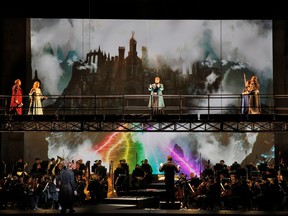
Reviews and recommendations are unbiased and products are independently selected. Postmedia may earn an affiliate commission from purchases made through links on this page.
Article content
Completing its current successful season, Calgary Opera is currently presenting Das Rheingold, the first of four musical dramas (operas) that make up Richard Wagner’s The Ring of the Nibelung. Following the old saying, the company has saved the best for last and this final production is the best of the season and a triumph as a production and in its musical values.
Advertisement 2
Article content
The most striking aspect of the production is the set and the concept of how the opera is presented. The original concept is the brainchild of director Brian Staufenbiel, who previously directed similar productions in Minnesota and, more recently, in Seattle. Staufenbiel is a multimedia director and in his concept, as described in the program, the world of Das Rheingold is conceived to take place “in a future where science and technology have caught up with nature, where the organic, the mechanical and the digital have begun to merge.”
Article content
Phrased in this exaggerated way, it may sound as if this is simply overwrought techno-pop that descends into sci-fi fantasy kitsch. But this is not the case here. Using the stage, the pit and a walkway above the stage, the action is presented on three different physical levels: the orchestra occupies the main stage with the conductor always present in view. Musically, this foregrounds the orchestra, which has a huge role to play in this opera, and allows the singers to be heard easily as they are mostly situated in front of the orchestra.
Article content
Advertisement 3
Article content
The costumes are epic in a style familiar to fans of Games of Thrones and other modern fantasy films. The back of the stage is used to project many different images, from ominous moving clouds to the grandeur of Valhalla Castle, the new home of the gods. The Valhalla Castle projection has a grandeur impossible to achieve on a conventional stage, and the other projections show a variety of atmospheric images that underline the dramatic action. Flexible and imaginative in its use of space and effects, this staging of the opera creates both the sense of the abstractly epic and the concretely specific, as demanded by the changing needs of the dramatic situation.
The orchestra pit is now the Rhine River, on which the opera opens, and also serves as Nibelheim’s underground mine, where Alberich, the evil dwarf, employs other enslaved dwarves to mine his horde of gold. The members of the Cantaré Children’s Choir are Alberich’s slaves in this production and are as effective in their purely dramatic role as they were in previous productions when it was his turn to sing.
Advertisement 4
Article content
The cumulative effect of all this is a contemporary realization of the spirit of what Wagner originally intended: a “total work of art,” where setting, action, and music merge into a coherent, integrated whole. The total effect of all these elements is truly splendid and is one of the best elements of the production.
While the singing is remarkably consistent and fine, it is the orchestra that often takes center stage (in this case, literally), with Jonathan Brandani once again displaying his remarkable abilities to bring out the best in the orchestra. Leading an expanded CPO, Brandani led the orchestra in a beautiful realization of the score, the tempos expertly measured and the big moments leaving their mark.
The famous atmospheric opening and majestic final pages received their due, as did the music for the Nibelheim scenes. Less obvious but equally important was the treatment of the conversational element of music, which needs subtle and constant nuances to make verbal inflections seem natural. Here Brandani was as impressive in the German opera as in the Italian operas he previously directed with the company.
Advertisement 5
Article content
Among the singers, all at the height of their roles, we must mention Rodell Rosel as Loge for his exceptional performance. Vocally characterizing the cunning and cunning Loge to perfection, Rosel was endlessly inventive in his portrayal of him, clearly the dramatic instigator of the action. As far as Wagnerian singers go, James Rutherford has the perfect voice for Wotan. Sonorous, with excellent notes both at the beginning and at the end of his record, Rutherford was the ideal Wotan, an imposing figure in a role for which he is perfectly suited in every way.
Given the size of the cast, not all singers can be mentioned here. But it is necessary to cite the excellent vocal performances of Boaz Daniel as Alberich and Guido Jentjens as Fasolt, both basses in the best Wagnerian tradition, with rich voices, excellent enunciation and clear vocal delivery. In smaller roles, Gordon Gietz made the most of his role as Mime (Alberich’s brother), and Elias Theocharidis as Froh and Connor Hoppenbrouwers as Donner were suitably divine and vocally resplendent, especially in the final scene. Kenneth Kellogg made a good vocal match for Jentens as Fafner in his smaller role.
Advertisement 6
Article content
The ladies were no less excellent: Catherine Daniel commanding as the goddess Erda, as were Jill Grove as Fricka and Anna Pompeeva as Freia. Juliana Krajcovic, Justine Ledoux and Yenny Lee were the three Rhinemaidens, all appropriately desperate and agitated at the theft of their gold.
For lovers of opera, but who doubt Wagner, there is nothing to fear here. This is the shortest of the Ring operas, as Wagner needed just three hours to present to his audience the history of the other Ring operas. Anyone who simply enjoys a good show will be thoroughly entertained by this production. Musically, Wagner’s music never fails to capture the imagination and both the singing and the orchestra are first class. A wonderful conclusion to one of Calgary Opera’s best recent seasons.
Article content
